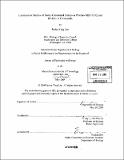Localization studies of sister-chromatid cohesion proteins MEI-S332 and RAD21 in Drosophila
Author(s)
Lee, Janice Ying, 1974-
DownloadFull printable version (7.347Mb)
Other Contributors
Massachusetts Institute of Technology. Dept. of Biology.
Advisor
Terry L. Orr-Weaver.
Terms of use
Metadata
Show full item recordAbstract
In cell division, the proper segregation of chromosomes requires sister-chromatid cohesion. This physical attachment between sister chromatids is established during DNA replication, maintained throughout mitosis and released at the metaphase-anaphase transition. In meiosis, sister-chromatid cohesion is released along the chromosome arms in the first meiotic division, but retained at the centromere until the second meiotic division. In this thesis, we have analyzed the localization of two cohesion proteins in Drosophila, MEI-S332 and RAD21. MEI-S332 localizes specifically to the centromere from prometaphase to the metaphase-anaphase transition in mitosis, and from prometaphase I to the metaphase II-anaphase II transition in meiosis. We find that the termini of MEI-S332 are required for its localization to chromosomes; these are also the regions that have homology to MEI-S332-like proteins in other organisms. The localization of MEI-S332 does not require the presence of cohesin, an evolutionarily conserved protein complex that is essential for the establishment and maintenance of cohesion, nor a replicated sister chromatid. However, MEI-S332 delocalization is dependent upon the activity of the separase pathway that regulates cohesin release. We have identified and characterized a key subunit of cohesin in Drosophila, DRAD21, and studied its localization in early stages of meiosis in spermatocytes. (cont.) DRAD21 is nuclear in prophase I, but is not visibly localized on chromosomes in later stages. Although DRAD21 is concentrated in centromeric regions after prometaphase in mitosis, MEI- S332 and DRAD21 do not physically interact in a complex in whole embryo extracts. Immunostaining of spread metaphase chromosomes for MEI-S332 and DRAD21 reveals that the two proteins are not localized to the same domains.
Description
Thesis (Ph. D.)--Massachusetts Institute of Technology, Dept. of Biology, 2004. Includes bibliographical references.
Date issued
2004Department
Massachusetts Institute of Technology. Department of BiologyPublisher
Massachusetts Institute of Technology
Keywords
Biology.